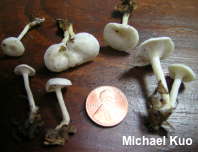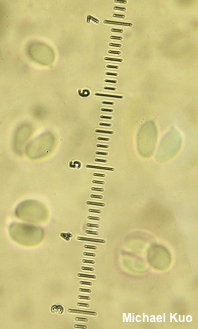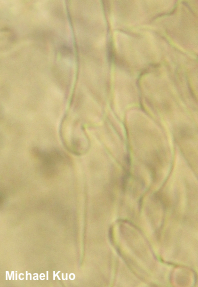| Major Groups > Gilled Mushrooms > Pale-Spored > Clitocyboid Mushrooms > Leucocybe candicans |

|
[Basidiomycota > Agaricales > Tricholomataceae > Leucocybe . . . ] Leucocybe candicans by Michael Kuo, 13 December 2022 This little clitocyboid mushroom appears in hardwood leaf litter in Europe and North America—and, sometimes, in conifer needle duff. When fresh and young (unlike the specimens illustrated here) it has a distinctive, whitish, hoary coating on its cap, and its ground color ranges from very pale yellowish to grayish. Soon, however, the mushroom fades to white, and the hoary covering disappears. At this point identification gets more difficult, since there are many small, whitish clitocyboid mushroomss out there. Other macroscopic features helping to distinguish Leucocybe candicans include the fairly dense mass of basal mycelium usually present at the base of the stem, the lack of a distinctive odor, and its close, whitish gills, which turn dull yellow when dried for the herbarium. Microscopic features include very small spores and the presence of clamp connections. Clitocybe candicans is a well-known synonym. Description: Ecology: Saprobic; growing scattered or gregariously in leaf litter under hardwoods or, less frequently, in needle duff under conifers; summer and fall; originally described from England (Bolton 1788); widely distributed in Europe and North America. The illustrated and described collection is from Illinois. Cap: 1–2 cm across; convex, becoming broadly convex with a central depression; thin; moist or dry; at first with a hoary covering, but soon bald; faintly yellowish to grayish, becoming white; the margin not lined. Gills: Beginning to run down the stem; close; short-gills frequent; white; becoming dull, pale yellow when dried for the herbarium. Stem: 2–3.5 cm long; 2–3 mm thick; more or less equal; bald; whitish; with copious white basal mycelium. Flesh: Thin; whitish; not changing when sliced Odor: Not distinctive. Chemical Reactions: KOH negative to yellowish on cap surface. Spore Print: White. Microscopic Details: Spores 3.5–5 x 2–2.5 µm; ellipsoid; smooth; hyaline in KOH; inamyloid. Basidia 28–30 x 4–5 µm; subclavate; 4-sterigmate. Cystidia not found. Pileipellis a cutis or ixocutis of elements 2.5–7.5 µm wide, smooth, hyaline in KOH; clamp connections present. REFERENCES: (C. H. Persoon, 1801) A. Vizzini, P. Alvarado, G. Moreno & G. Consiglio, 2015. (Kauffman, 1918; Harmaja, 1969; Bigelow, 1982; Breitenbach & Kränzlin, 1991; Schalkwijk-Barendsen, 1991; Kuyper, 1995; McNeil, 2006; Gregory, 2007; Buczacki et al., 2013; Alvaredo et al., 2015; Baroni, 2017; Vesterholt, 2018; Læssøe & Petersen, 2019; Kibby, 2020.) Herb. Kuo 09301101. This site contains no information about the edibility or toxicity of mushrooms. |
© MushroomExpert.Com |
|
Cite this page as: Kuo, M. (2022, December). Leucocybe candicans. Retrieved from the MushroomExpert.Com Web site: http://www.mushroomexpert.com/leucocybe_candicans.html |


